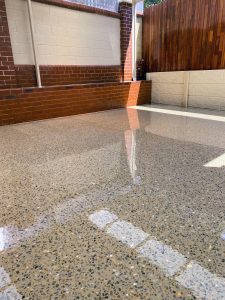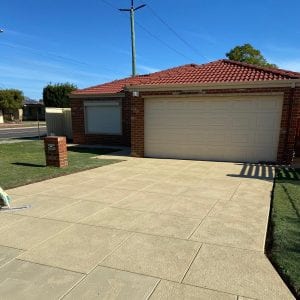Exposed aggregate is a type of decorative concrete used for driveways, patios, and walkways; this concrete is made by stripping back top concrete’s top layer, revealing the array of beautiful aggregate beneath. Using exposed aggregate for your driveways brings a number of benefits: Exposed aggregate adds curb appeal, is weather-resistant, and comes in a variety of options for both the aggregate and concrete. Additionally, one of the biggest draws of exposed aggregate is its relatively low maintenance, requiring only basic cleaning and occasional resealing. Resealing is especially important for exposed aggregate because it helps the concrete maintain its highly lustrous appearance and extend its lifespan by adding further weather resistance. So let’s take a look at some of the best ways to seal your exposed aggregate driveway to keep it looking pristine for years!
What Is Concrete Sealer?
Concrete sealer is a coating applied to the top of concrete, which protects it from corrosion, staining, and weathering. There are two main types of sealer for concrete driveways, topical and penetrating.
- Topical – Topical sealers are usually acrylic-like resin that needs to be applied dry. These sealers coat the concrete in a high gloss finish, which protects it from weather, staining, and adds an aesthetic sheen. Topical sealers are the most common choice for exposed aggregate. It adds to the already highly decorative nature of the concrete while also protecting it and increasing its overall life span. Topical sealers also have the added advantage of holding down and sealing and loose stones from the aggregate. The only downside to consider in topical sealers is that they often reduce the traction of the concrete when wet.
- Penetrating – Penetrating sealers instead soak into the concrete and seal it through a chemical reaction. These sealers are more passive and do not alter the look or feel of the concrete or aggregate. The major draw of penetrating sealers is that they generally last longer than topical sealers and require less maintenance.
Which Option Is Best?
The choice between topical or penetrating is preferential as both sealers work well to preserve exposed aggregate. Penetrating sealer is excellent for how long it lasts, and its low maintenance and generally easier application make it a fine choice. However, we believe that a high gloss, acrylic, topical sealer adds the most attractive finish to exposed aggregate; the high gloss sheen allows the concrete to shine and accentuates the beauty of the aggregate stones.
How To Seal Your Driveway
Each sealer has detailed instructions on the specifics of its application, but when sealing a driveway, the basic steps looks like this:
- Clean Your Driveway: You should completely clean your driveway with thorough power washing. Be wary of the power of the stream, as a too intense spray of water can knock some of the aggregate stones loose.
- Remove Stains: Use rust remover, degreaser, or other stain-removing solutions to clean your driveway of stains or oil spots.
- Let Dry: While most penetrative sealers can be applied damp, you will need to let your driveway fully dry before applying topical sealer.
- Apply Sealer: Use a 1/2 inch roller and pump sprayer to apply the sealer; roll the sealer on quickly to avoid streaking and roll marks.
- Let Dry: Allow the sealer to dry for the time specified in its instructions; during this time, ensure that the driveway is unused and devoid of foot traffic.
If you have any questions about sealing exposed aggregate or its general maintenance, you can ask us here! Or, if you are looking to increase your driveways curb appeal by installing exposed aggregate, you can view our services here.




